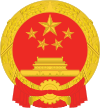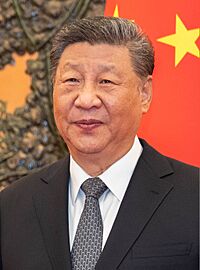President of China facts for kids
Quick facts for kids President of thePeople's Republic of China |
|
|---|---|

|
|

National Emblem of China
|
|
| Office of the President of the People's Republic of China |
|
| Style |
|
| Reports to | Standing Committee of the National People's Congress |
| Residence | Zhongnanhai |
| Seat | Beijing |
| Nominator | Presidium of the National People's Congress |
| Appointer | National People's Congress |
| Term length | Five years
renewable indefinitely
|
| Constituting instrument | Constitution of China (1982) |
| Precursor | Chairman of the Central People's Government (1949–1954) |
| Formation | 1 January 1912 (Republican era) 27 September 1954 (current form) |
| First holder | Sun Yat-sen (Republican era) Mao Zedong (current form) |
| Abolished | 1975–1982 |
| Deputy | Vice President |
| Salary | CN¥136,620 per annum est. (2015) (USD18,721) |
| President of the People's Republic of China |
|||||||
|---|---|---|---|---|---|---|---|
| Simplified Chinese | 中华人民共和国主席 | ||||||
| Traditional Chinese | 中華人民共和國主席 | ||||||
|
|||||||
| alternative name | |||||||
| Simplified Chinese | (中国)国家主席 | ||||||
| Traditional Chinese | (中國)國家主席 | ||||||
|
|||||||
The President of China is the official leader who represents the People's Republic of China. This role is mostly ceremonial, meaning it has many duties like a head of state but doesn't hold much real power on its own. However, since 1993, the person who is President also holds other very powerful positions. This includes being the leader of the Chinese Communist Party (CCP) and the head of the military. This makes the President the de facto (actual) top leader of China.
The President's job is part of China's unique government system, where the National People's Congress (NPC) is the highest power. The President works with the NPC's Standing Committee to do things a head of state would normally do in other countries. For example, the President can deal with international matters if the NPC Standing Committee agrees.
Contents
History of the Presidency
Early Beginnings
The idea of a state representative in China goes back to 1912. That's when Sun Yat-sen became the first leader of the Republic of China. The current form of the presidency started on October 1, 1949. It was first called the Chairman of the Central People's Government.
The 1954 Constitution
In 1954, China created a new Constitution. This document officially set up the role of "state chairman." This chairman had some ceremonial powers, similar to today's President. The chairman also had military powers, leading the armed forces and the National Defence Council. They could also call special meetings with top government officials.
Mao Zedong, a very important leader, was the first state chairman. He was elected in 1954.
Changes and Abolition
In 1959, Liu Shaoqi became the state chairman. He was re-elected in 1965. However, during the Cultural Revolution in 1966, Liu Shaoqi lost his power. In 1968, he was officially removed from all his positions, including state chairman. This was against the Constitution, which said only the NPC could remove him. After Liu was removed, the position of state chairman was empty.
In 1975, China adopted a new Constitution that completely removed the state chairman position. The duties of representing the state were given to the chairman of the NPC Standing Committee instead. This change emphasized that the Communist Party was in charge of everything.
The Presidency Returns in 1982
In 1982, the presidency was brought back with a new Constitution. Leaders decided it was important to have a President to represent the country. However, they wanted the President to have limited powers. The idea was for the President to be a symbolic figure, like a president in a country with a parliament. The real power was meant to be with the leader of the Communist Party, the Premier (head of government), and the head of the military.
At first, these top jobs were held by different people. But in 1993, Jiang Zemin became President. He was already the leader of the Communist Party and the military. This made him the undisputed top leader of China. Since then, the President of China has also been the most powerful person in the Party and the military.
In 2018, a big change happened. The rule that limited the President to two terms was removed. This means the President can now serve for an unlimited number of terms. Xi Jinping, the current President, explained this change was to match the presidency with his other powerful roles, which don't have term limits.
How the President is Chosen
Who Can Be President?
To become President, a person must:
- Be a Chinese citizen.
- Have the right to vote and be elected.
- Be at least 45 years old.
The Election Process
The President is chosen by the National People's Congress (NPC). The NPC's executive body, called the Presidium, suggests a candidate. In reality, the Chinese Communist Party decides who will be nominated. So far, only one candidate has ever been nominated for the presidency.
The NPC then votes to elect the President. They can also vote to remove the President from office. Both decisions are made by a majority vote. The President serves for five years, which is the same length as the NPC's term. Since 2018, the President must take an oath to the Constitution before starting their job.
| No. | Year | Electoral college | Total Seats | President-elect | Voters | For | Against | Abstain | Result |
|---|---|---|---|---|---|---|---|---|---|
| 1 | 1954 | 1st National People's Congress | 1226 | Mao Zedong | 1210 | 1210 | 0 | 0 | Elected |
| 2 | 1959 | 2nd National People's Congress | 1235 | Liu Shaoqi | Elected | ||||
| 1964 | 3rd National People's Congress | 3040 | Elected | ||||||
| N/A | 1975 | 4th National People's Congress | 2864 | Presidency vacant | |||||
| 1978 | 5th National People's Congress | 3497 | Presidency abolished | ||||||
| 3 | 1983 | 6th National People's Congress | 2978 | Li Xiannian | Elected | ||||
| 4 | 1988 | 7th National People's Congress | 2970 | Yang Shangkun | 2970 | 2812 | 124 | 34 | Elected |
| 5 | 1993 | 8th National People's Congress | 2977 | Jiang Zemin | 2918 | 2858 | 35 | 25 | Elected |
| 1998 | 9th National People's Congress | 2983 | 2947 | 2882 | 36 | 29 | Elected | ||
| 6 | 2003 | 10th National People's Congress | 2985 | Hu Jintao | 2944 | 2937 | 4 | 3 | Elected |
| 2008 | 11th National People's Congress | 2987 | 2964 | 2956 | 3 | 5 | Elected | ||
| 7 | 2013 | 12th National People's Congress | 2987 | Xi Jinping | 2956 | 2952 | 1 | 3 | Elected |
| 2018 | 13th National People's Congress | 2980 | 2970 | 2970 | 0 | 0 | Elected | ||
| 2023 | 14th National People's Congress | 2977 | 2952 | 2952 | 0 | 0 | Elected | ||
What the President Does
The President represents China both inside the country and to other nations. The Constitution says the presidency is a state body that performs state activities.
The President has several powers, but most of them need the approval of the National People's Congress (NPC). These powers include:
- Announcing new laws.
- Choosing and removing the Premier (head of government) and other ministers.
- Granting pardons (forgiveness for crimes).
- Declaring states of emergency.
- Issuing orders for large-scale actions.
- Giving out state awards.
- Appointing and removing ambassadors to other countries.
- Signing and canceling treaties with foreign countries.
One special power is conducting state visits to other countries. This is the only power that doesn't need NPC oversight. Because most presidential powers need NPC approval, the President is mainly a symbolic figure. They don't have direct control over how the government runs.
The President also suggests who should be the Premier. While the NPC confirms this choice, they have never rejected a nomination. The Premier is a very important job, so this power can give the President some influence.
Line of Succession
If the President's office becomes empty, the Vice President takes over. If both offices become empty, the chairman of the NPC Standing Committee temporarily acts as President. This continues until the NPC can elect a new President and Vice President.
Current Succession Order
| No. | Position | Incumbent | Party | |
|---|---|---|---|---|
| 1 | Vice President of the People's Republic of China | Han Zheng | Communist | |
| 2 | Chairman of the Standing Committee of the National People's Congress | Zhao Leji | Communist | |
Spouses of Presidents
Many Presidents have had a spouse during their time in office. The current spouse is Peng Liyuan, who is married to President Xi Jinping.
| No. | Image | Spouse | President | Tenure |
|---|---|---|---|---|
| 1 |  |
Jiang Qing | Mao Zedong | 27 September 1954 – 27 April 1959 |
| 2 |  |
Wang Guangmei | Liu Shaoqi | 27 April 1959 – 31 October 1968 |
| 3 |  |
Lin Jiamei | Li Xiannian | 18 June 1983 – 8 April 1988 |
| Vacant | Yang Shangkun | 8 April 1988 – 27 March 1993 | ||
| 4 |  |
Wang Yeping | Jiang Zemin | 27 March 1993 – 15 March 2003 |
| 5 |  |
Liu Yongqing | Hu Jintao | 15 March 2003 – 14 March 2013 |
| 6 |  |
Peng Liyuan | Xi Jinping | 14 March 2013 – Incumbent |
Images for kids
-
Liu Shaoqi
(27 April 1959 –
31 October 1968) -
Dong Biwu
(Vice-Chairman acted as the Chairman
31 October 1968 –
24 February 1972;
Acted Chairman
24 February 1972 –
17 January 1975) -
Song Qingling
(Vice-Chairwoman acted as the Chairwoman
31 October 1968 –
24 February 1972;
Honorary Chairwoman
16 May 1981 –
29 May 1981) -
Zhu De
(17 January 1975 –
6 July 1976) -
Song Qingling
(Acting Chairwoman
6 July 1976 –
5 March 1978) -
Li Xiannian
(18 June 1983 –
8 April 1988) -
Yang Shangkun
(8 April 1988 –
27 March 1993) -
Jiang Zemin
(27 March 1993 –
15 March 2003) -
Hu Jintao
(15 March 2003 –
14 March 2013) -
Xi Jinping
(14 March 2013 –
present)
See also
 In Spanish: Presidente de la República Popular China para niños
In Spanish: Presidente de la República Popular China para niños












